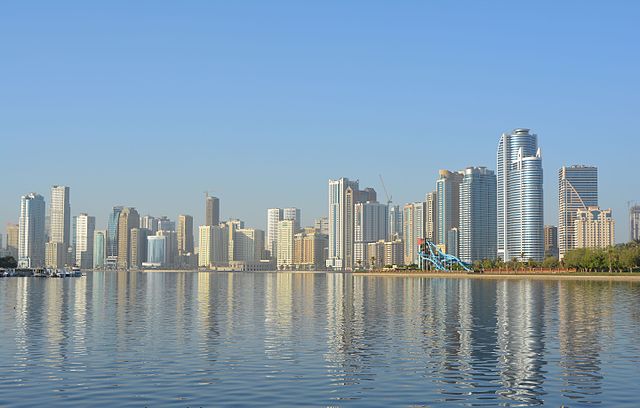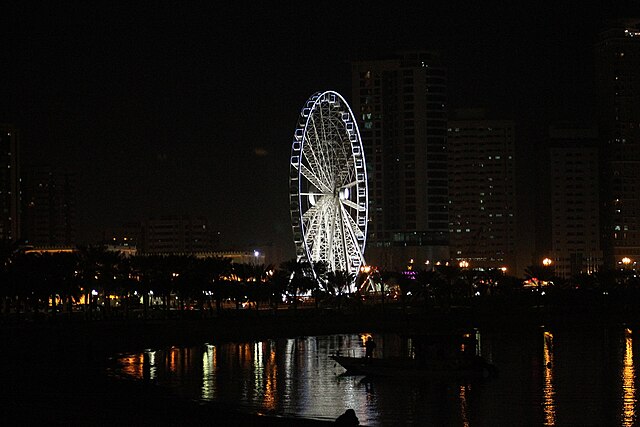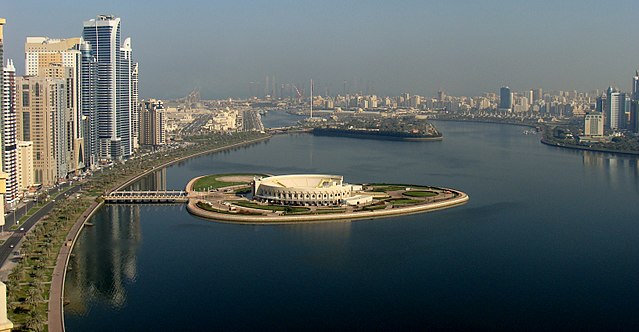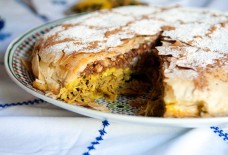Sharjah – The Friendly-Cultural Heart of the United Arab Emirates
By: Habeeb Salloum/Arab America Contributing Writer

Sharjah and its capital with the same name, derive their name from the Arabic, al-shariqah (rising from the East). The emirate is the third largest of the seven states in the United Arab Emirates. More than its sister emirates, it has long been known, in the southern Arabian Gulf area, as an intellectual centre, with an attachment to its past.
This is the best reflected in the five museums in the city of Sharjah focusing on archaeology, art, the state’s legacy, natural history, and science. They enhance the people’s awareness of their past, keeping alive the local heritage and culture. Along with the state’s restored monuments which played a key role in the history of the Emirate, including the Old Fortress or Sharjah Fort in the city of Sharjah which was built in 1823 – testify to Sharjah’s commitment to its past.
This pride in their ancestors’ accomplishments is complemented in today’s Emirate by its inhabitants who are open, friendly, and helpful to strangers. When visitors ask directions or stop for a friendly chat, the Sharjahians, more often in English than in Arabic, will respond with a friendly smile and even walk with the visitors to show them the way.
As in the past, when their forefathers welcomed travellers who arrived after long journeys by dhow (Arab sailing ships) or camel caravan, the people of Sharjah continue that tradition of being courteous to strangers – giving travellers a feeling of belonging. With this congenial lifestyle, cultural heritage and the aura of desert romance which has long fascinate Westerners, the city becomes an appealing tourist destination.

The state of Sharjah, flanked by the Arabian Gulf to the west and the Gulf of Oman to the east, has an area of 2,600 sq km (1,004 sq mi) and a population of almost 1,800,000 – over half residing in the capital, once known as Mleiha. In the pre-Islamic era, it was an important centre of commerce and trade in incense, perfume and spices between Yemen and the Mediterranean.
Continuing in this tradition, Sharjah is today the home of 4% of the UAE’s industry, from petrochemicals to textiles, powering the Emirates growth. Aiding this surge are its: two deep water container ports – Mina Khalid and Khor Fakkan (a Sharjah enclave on the Gulf of Oman); Expo Centre, which features annually about 80 exhibitions and events; modest oil output; agriculture production, in and around the oasis of Dhayd; and airport which serves as an important air cargo hub for many of the world’s major carriers.
Modern Sharjah and its enclaves of Khor Fakkan Kalba and a part of the town of Dibba, combine the old and the new. Their centuries old quaint Arab homes stand side by side with a sophisticated street and multilane highways, modern towering banks, skyscrapers, first-class hotels, and superb villas. Everywhere, lush green parks and tree-line wide avenues intersected by attractive grass, flower and shrub-topped roundabouts, cover a land where only a few decades ago the sands blew freely.
In the city of Sharjah, Khalid Lagoon, encircled by palm trees, is one of the most charming spots in the city. The five km (3 mi) long Buhaira Corniche curving around the Lagoon is bordered by well-lit lush grass and benches, set in the shade of palms. In the evenings, it is a relaxing outdoor area where families and visitors can promenade and enjoy the refreshing air, then stop for a while at the traditional coffee house – a replica of those that once existed in profusion.
Other sedate spots are the flower-saturated seaside Corniche and the Rolla Square Park that takes its name from what was once a 200-year-old rolla (also called banyan) tree – now dead- under which, in the past, many of the town’s meetings took place. The tree has been immortalized in a unique memorial set in the centre of a grassy park.
Keeping alive the historical importance of this tree, other rollas were planted and now thrive along the edges of the park. Today, under their shades, people picnic and perhaps, remember the famous lone tree from long ago.
The greenery throughout the city is complemented by the recently built structures which incorporate modern architectural designs and elements from the Arab past, creating an unusual blend of the old and new. This is best reflected in the Sharjah Souk (market) popularly known as the ‘Blue Souk’ next to the Lagoon- a magnificent work of art.
Completed in 1978, it is a living reminder of the grandeur of classical Islamic architecture. It captures the essence of Arab medieval edifices and is said to surpass the renowned Damascus Umayyad Mosque in artistic appeal. What makes it even more attractive are its wind towers which catch the breezes and funnel them below – a traditional method of air conditioning once employed in the Gulf area.
A shopper’s paradise, the Souk combines beauty and utility. Its approximately 600 shops, housed in double wings connected by bridges, stock goods from the four corners of the world. Splendid varieties of gold jewelry, richly displayed in an impressive fashion, are by themselves reason enough to visit the Souk. The Souk has been so successful that another similar market, Al Mujarrah, has been built a short distance away.

The revived architectural splendour and treasures of the past are to be found throughout the city. The eye-catching Sharjah International Airport, the palace of the ruler, Sheikh Sultan Dr. Sultan bin Mohammed Al Qasimi, the seashore food markets, and, above all, Sharjah’s mosques incorporate many characteristics of the Islamic decorative arts. The mosques’ elaborate Arabic inscriptions and engravings blend in well with their spaciousness and simple colouring. At night, when lit up, they appear like gems filling the skyline.
The attributes in the city’s fine touristic facilities added to the warm sunny climate in winter; unspoiled clean golden beaches; excellent eating places, serving foods from all over the world; over 20 top class hotels and reasonable prices, make Sharjah an attractive holiday mecca. The only drawback is that Sharjah is dry. However, a 10-minute taxi ride away is Dubai whose hotels offer all types of liquors.
After exploring the city, a fine way to end the day is to dine in Sharjah’s Dhow Restaurant- a converted old dhow moored in Khalid Lagoon near the New Souk. In this aura of a romantic past, a visitor can reminisce about Sharjah’s hasty evolvement from a land of barren sand to an ultra-modern state, appealing to tourists.


